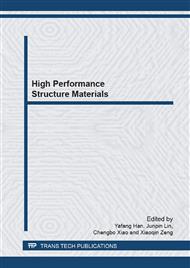[1]
K.Y. Sohn, J.A. Yurko, F.C. Chen, J.W. Jones, J.E. Allison, Proc. Auto Alloys II, San Antonio, TX, The Material, Metals and Minerals Society. (1988) 81.
Google Scholar
[2]
R.S. Busk, Magnesium Products Design. (1987) 499.
Google Scholar
[3]
B.B. Clow, Magnesium Industry Overview, Advanced Materials and Processes. 150 (1996) 33.
Google Scholar
[4]
G. Song, A. Atrens, Corrosion Mechanisms of Magnesium Alloys, Advanced Engineering Materials. 1 (1999) 11-33.
Google Scholar
[5]
G.L. Song, A. Atrens, Understanding Magnesium Corrosion, Advanced Engineering Materials. 5 (2003) 837.
Google Scholar
[6]
G. Song, Recent Progress in Corrosion and Protection of Magnesium Alloys, Advanced Engineering Materials. 7 (2005) 563.
Google Scholar
[7]
N. Winzer, A. Atrens, G. Song, E. Ghali, W. Dietzel, K.U. Kainer, N. Hort, C. Blawert, A Critical Review of the Stress Corrosion Cracking (SCC) of Magnesium Alloys, Advanced Engineering Materials. 7 (2005) 659-693.
DOI: 10.1002/adem.200500071
Google Scholar
[8]
G. Song, A. Atrens, Recent Insights into the Mechanism of Magnesium Corrosion and Research Suggestions, Advanced Engineering Materials. 9 (2007) 177-183.
DOI: 10.1002/adem.200600221
Google Scholar
[9]
J.X. Jia, G.L. Song, A. Atrens, Influence of geometry on galvanic corrosion of AZ91D coupled to steel, Corrosion Science. 48 (2006) 2133-2153.
DOI: 10.1016/j.corsci.2005.08.013
Google Scholar
[10]
N. Winzer, A. Atrens, W. Dietzel, G. Song, K.U. Kainer, Comparison of the linearly increasing stress test and the constant extension rate test in the evaluation of transgranular stress corrosion cracking of magnesium, Materials Science and Engineering A. 472 (2008).
DOI: 10.1016/j.msea.2007.03.021
Google Scholar
[11]
N. Winzer, A. Atrens, W. Dietzel, V.S. Raja, G. Song, K.U. Kainer, Materials Science and Engineering A. (2008).
Google Scholar
[12]
R.G. Li, Y. Xu, W. Qi, J. An, Y. Lu, Z.Y. Cao, Y.B. Liu, The effect of crystallographic orientation on the active corrosion of pure magnesium, Mater. Charact. 59 (11) (2008) 1643.
Google Scholar
[13]
H.K. Lim, S.W. Sohn, D.H. Kim, J.Y. Lee, W.T. Kim, D.H. Kim, J. Effect of addition of Sn on the microstructure and mechanical properties of Mg–MM (misch-metal) alloys, Alloys Compd. 454 (1-2) (2008) 515.
DOI: 10.1016/j.jallcom.2007.09.074
Google Scholar
[14]
T.B. Massalski, H. Okamoto, P.R. Subramanian, L. Kacprzak, Binary Alloy Phase Diagrams, The Materials Information Society. 1 (1990) 899.
Google Scholar
[15]
Alan A. Luo, Anil K. Sachdev. Proceedings of Magnesium Technology, San Francisco, TMS 2009, pp.437-443.
Google Scholar
[16]
G.L. Song, A. Atrens, D. StJohn, An hydrogen evolution method for the estimation of the corrosion rate of magnesium alloys, Magnesium Technology 2001 Symposium, Minerals, Metals & Materials Soc., (2001) 255-262.
DOI: 10.1002/9781118805497.ch44
Google Scholar
[17]
X.Y. Kang, Effects of chemical composition on the microstructure and mechanical properties of as-cast Mg-Al-Sn Alloys, Shanghai JiaoTong University. (2010) 18-19.
Google Scholar
[18]
L.H. Mei, Solid-solution Aging and Electronic Structure of Mg-5wt% Sn Alloy, Sichuan University. (2007) 102-115.
Google Scholar
[19]
K. C. Park, Microstructure and Corrosion properties of Mg-xSn-5Al-1Zn (x=0, 1, 5, and 9 mass%) Alloys, Materials Transactions. 51(2010) 472-476.
Google Scholar
[20]
Z. Shi, M. Liu, A. Atrens, Measurement of the corrosion rate of magnesium alloys using Tafel extrapolation, Corrosion Science. 52 (2010) 579.
DOI: 10.1016/j.corsci.2009.10.016
Google Scholar


